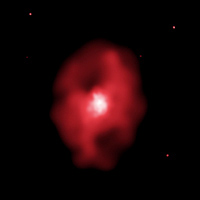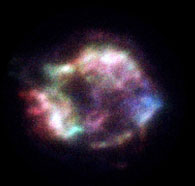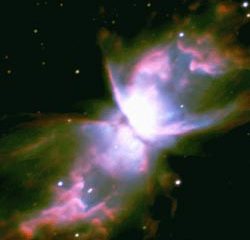This area deals with the fundamental laws and building blocks of nature and how they interact, the properties and the behavior of matter, and research into space and time and their structures.
innovations-report provides in-depth reports and articles on subjects such as astrophysics, laser technologies, nuclear, quantum, particle and solid-state physics, nanotechnologies, planetary research and findings (Mars, Venus) and developments related to the Hubble Telescope.

Astronomers have found the most powerful eruption in the universe using NASA’s Chandra X-ray Observatory. A super massive black hole generated this eruption by growing at a remarkable rate. This discovery shows the enormous appetite of large black holes, and the profound impact they have on their surroundings.
The huge eruption was seen in a Chandra image of the hot, X-ray emitting gas of a galaxy cluster called MS 0735.6+7421. Two vast cavities extend away from the super mas

The Swift X-ray Telescope (XRT) has seen first light, capturing a dazzling image of Cassiopeia A, a well-known supernova remnant in the Milky Way galaxy, and also has discovered its first gamma-ray-burst afterglow.
The XRT is one of three instruments aboard the NASA-led Swift satellite, which was launched on 20 November 2004. The XRT was built at Penn State with partners at the Brera Astronomical Observatory in Italy and the University of Leicester in England.
“We

For the first time, a team of astronomers based in Germany has detected the presence of magnetic fields in the central stars of four planetary nebulae. Planetary nebulae are expanding gas shells that remain after Sun-like stars eject their outer layers at the end of their lifetimes. It is a long-standing and unsolved mystery why 80% of all planetary nebulae are not spherical. Theories suggest that magnetic fields play a role in shaping planetary nebulae. The team, led by Stefan Jordan, has now

University of Arizona scientists, working on one of the most stunning robotic space missions ever attempted, head for Germany next week.
Their experiments ride on the Huygens probe to Saturn’s giant moon, Titan, part of the four-year NASA/European Space Agency/Italian Space Agency Cassini Huygens mission to the Saturn system.
The probe separated from the Cassini spacecraft early Saturday, Dec. 25, 2004, central European time (or about 8:30 p.m. Dec. 24, Arizona ti

MIT astrophysicists and their colleagues are excited about the latest milestone toward developing a giant telescope that among other things will allow direct observations of planets orbiting stars in solar systems beyond ours.
On Dec. 13 the Carnegie Observatories of the Carnegie Institution signed an agreement with the University of Arizona’s Steward Observatory Mirror Lab to produce the first mirror for the Giant Magellan Telescope (GMT). The telescope will have a diameter of

SPACE DIGEST: JANUARY 2005
This release contains a summary of some significant astronomical and space events that will be taking place during January. It has been written in order to assist the media in planning and researching future stories related to space science and astronomy, particularly those with UK involvement. It is not intended to be fully comprehensive. Dates and times may be subject to change.
EINSTEIN YEAR
2005 is Einstein Year, the UK’s contribution to